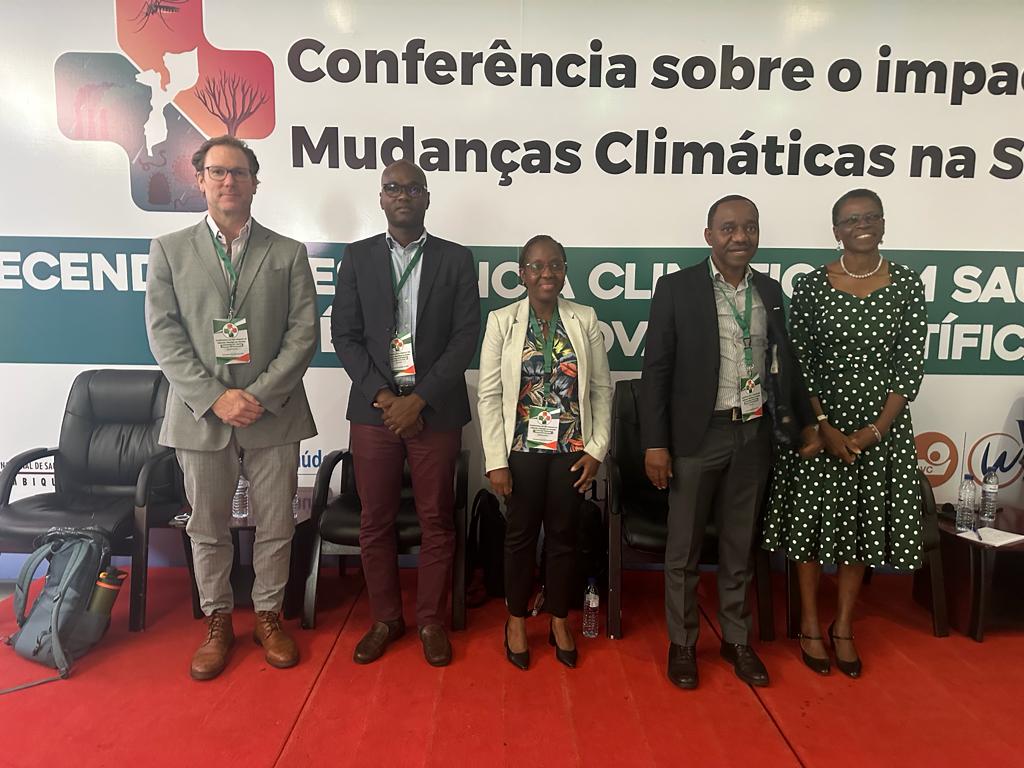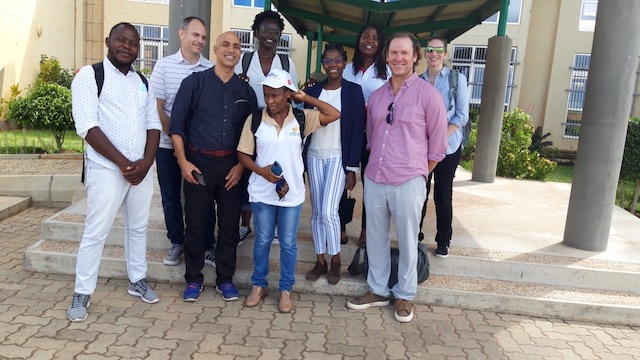Malaria is among the greatest public health threats in Mozambique, with more than 12 million cases in 2022. In a discussion with James Colborn, Senior Malaria Advisor at the Clinton Health Access Initiative and member of the Forecasting Healthy Futures Institute for Health Modeling and Climate Solutions (IMACS), Colborn discusses his malaria work in Mozambique, as well as his thoughts on addressing climate change and leveraging early warning systems.
Q: As a senior malaria adviser at the Clinton Health Access Initiative, working mostly on combating malaria in Mozambique, what does your role involve?
In the most general sense, my job involves helping the Mozambique National Malaria Control Program (NMCP) make evidence-based decisions to further their efforts to eliminate malaria. More specifically, I offer suggestions for what interventions should be implemented. For example, I worked with the Malaria Atlas Project and Swiss Tropical and Public Health Institute to determine the cost-effectiveness of different mixes of interventions. I also worked with Lancaster University to implement a climate-informed early warning system for malaria in order to help the country be more resilient to climate change.
Of course, sustainability is one of the most important considerations for my work, so ensuring that the work can continue with or without additional support is vital. I try to build capacity by conducting trainings and providing mentorship as well as identifying training/learning opportunities for my colleagues outside of Mozambique.
Q: Given Mozambique has the fourth-largest malaria burden in the world, with approximately 10 million cases and thousands of deaths reported annually, can you shed light on why that is? What are the biggest challenges?
I think the initial reaction with these types of questions is to look at factors like financing for malaria interventions, the underlying eco-epidemiology of the country, and even climate change. And all these factors are probably playing a role, though I don’t think the impact of the development status of the country can be understated.
Malaria is primarily a disease of rural and poor populations, and over 60% of Mozambique’s population lives in rural areas. Mozambique is also one of the world’s poorest countries, which means that in addition to living in areas with extremely high malaria transmission, most people are too far from health facilities to get appropriate treatment in a timely manner.
This impact of poverty and development are probably among the biggest challenges we face in the country, given that most malaria interventions do not directly address poverty or improving people’s ability to reach health facilities (though supporting community health workers does try to address access to care by essentially bringing treatment to the communities).
Funding for malaria interventions in Mozambique has fortunately been consistently high relative to some neighboring countries, though given the high burden existing funding levels still aren’t sufficient to cover all the needs we’ve identified in the country. Additionally, some interventions such as indoor residual spraying and the use of insecticide-treated bed nets (ITNs) have been losing some of their effectiveness due to things like increasing insecticide resistance among vectors and changing vector behavior, which when combined with a lack of enough new tools to address these issues, has been an added challenge we’ve had to face.
All that said, climate and climate change are also challenges to achieving our goals of elimination. The country has a very diverse climatological profile, with key patterns like seasonality of rainfall (and as a result seasonality of the high transmission season for malaria) varying significantly from the north to the south of the country. Seasonality, in particular, has a major impact on the effectiveness of many key interventions used by the country, meaning that interventions cannot be implemented in all areas and expected to have the same impact. Additionally, climate change is impacting the seasonality of malaria transmission in the country by making the onset, duration, and magnitude of the transmission season more variable, which in turn impacts the effectiveness of our interventions.
Q: Mozambique has been working to enhance its climate-sensitive infectious disease (CSID) early warning systems. Can you tell us how they work and how effective they are today?
The primary malaria early warning system (MEWS) that the NMCP is using utilizes a spatio-temporal model, meaning it includes both location and time components, and takes advantage of the delay between the impacts of rain and temperature and malaria cases, to predict future increases in malaria transmission. The system is also unique in that it utilizes different thresholds based on transmission intensity to define an outbreak, and further incorporates the confidence in the model’s prediction. This allows responses based on the system’s predictions to be tailored to different situations and consider things like availability of resources to respond to a predicted outbreak.
So far, the system is still being integrated into the country’s routine malaria information system, so its impact on both preventing epidemics and saving valuable resources is yet to be fully determined. That said the system has proven effective at predicting future outbreaks up to 8 weeks in advance. We are, however, excited about our ability to integrate the system directly into the DHIS2-based malaria dashboard so that all steps-accessing/downloading weather data, running the algorithm, and producing visualizations of the output predictions-are fully automated. All that said, we also recognize that the most difficult step (as is the case with all early warning systems) will be ensuring that proper governance, financing, and roles and responsibilities among partners and governmental agencies are in place to enable the outputs of the system to be acted upon to prevent epidemics.


Q: What has been the impact of climate change on forecasting malaria epidemics?
The major way, in my opinion, that climate change has impacted forecasting malaria epidemics is that it has put increased importance on the need for systems that can forecast epidemics. This is because climate change has made and will likely continue to make malaria transmission more unpredictable in many areas, so previous assumptions on key information such as when and where transmission seasons will begin, and end may no longer be valid. For example, a reasonable future scenario may be one where the most cost-effective way to deploy key malaria interventions may not be by doing them at the same place and time each year, but rather through deployment in response to forecasted conditions that are most receptive to significant malaria transmission.
Interestingly, one unexpected result of the impact of climate change on forecasting malaria epidemics has been a recognition of the need to better integrate climate and health data overall, and more specifically about the positive benefits that routinely analyzing climate and health data can have on not only mitigation of climate sensitive diseases but building resilient health systems overall. There is still much work to do to bridge the gap between climate and health science, but we are moving in the right direction!
Q: In 2021, the Global Fund to Fight AIDS, Tuberculosis and Malaria requested an analysis to figure out why malaria cases have seemingly flatlined. What did your analysis conclude and what role do you expect early warning systems to play in eliminating malaria?
Unfortunately, our analysis didn’t find any “smoking guns” that explained why the significant investment in decreasing malaria transmission in the center and north of the country didn’t have the expected impact. We did however find many contributing factors, including shifting vector behavior combined with insecticide resistance resulting in less than complete coverage with effective vector control interventions, and interestingly an increase in the country’s ability to detect and report cases. In other words, we found that while some of the flatlining was likely real, some of it was due to an increase in the percentage of actual cases that were reported and not an actual increase (or lack of decrease) in transmission.
As climate change makes malaria transmission more unpredictable it will be increasingly important to prepare for unexpected increases in malaria transmission through effective forecasting systems and more resilient health systems. These early warning systems play an increasingly important role as transmission decreases because transmission moves from being endemic to epidemic, meaning that reactive interventions become more important in lower transmission settings. Ultimately, where we want to get to prior to elimination is being able to detect and respond to each individual case of malaria, and effective early warning systems can help build this capacity for responding to urgent alerts of epidemics and outbreaks.

Visit ForecastingHealthyFutures.org to learn more and follow us on Twitter @FHF_global
About IMACS
The institute for Malaria and Climate Solutions (IMACS) is a virtual center of excellence with the mission to help countries accurately anticipate climate-driven changes in malaria transmission and direct their control measures with more precision.
IMACS links experts around the world, advancing the multidisciplinary science of designing increasingly sophisticated early warning systems for malaria prediction. Those systems unlock the potential for precision programming and cost-effective disease elimination; paving the way for successful elimination despite the complexity introduced by climate change.
